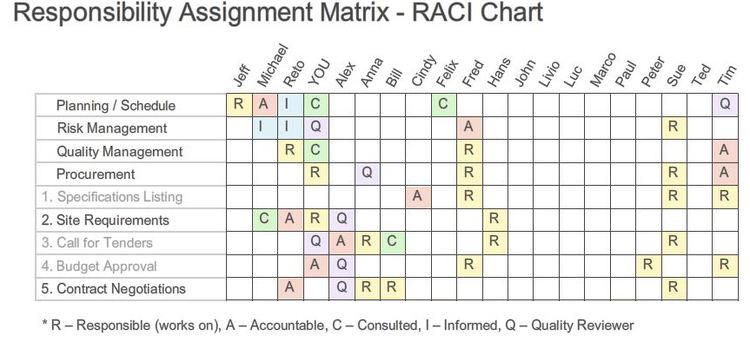 | ||
A responsibility assignment matrix (RAM), also known as RACI matrix /ˈreɪsiː/ or linear responsibility chart (LRC), describes the participation by various roles in completing tasks or deliverables for a project or business process. It is especially useful in clarifying roles and responsibilities in cross-functional/departmental projects and processes.
Contents
- Key responsibility roles RACI model
- Role distinction
- Alternatives
- PARIS
- PACSI
- RASCI
- RASI
- RACIQ
- RACI VS
- CAIRO
- DACI
- RAPID
- RATSI
- Variations
- RACI alternative scheme
- ARCI decisions
- References
RACI is an acronym derived from the four key responsibilities most typically used: Responsible, Accountable, Consulted, and Informed.
Key responsibility roles (RACI model)
Very often the role that is accountable for a task or deliverable may also be responsible for completing it (indicated on the matrix by the task or deliverable having a role accountable for it, but no role responsible for its completion, i.e. it is implied). Outside of this exception, it is generally recommended that each role in the project or process for each task receive, at most, just one of the participation types. Where more than one participation type is shown, this generally implies that participation has not yet been fully resolved, which can impede the value of this technique in clarifying the participation of each role on each task.
Role distinction
There is a distinction between a role and individually identified people: a role is a descriptor of an associated set of tasks; may be performed by many people; and one person can perform many roles. For example, an organization may have ten people who can perform the role of project manager, although traditionally each project only has one project manager at any one time; and a person who is able to perform the role of project manager may also be able to perform the role of business analyst and tester.
The matrix is typically created with a vertical axis (left-hand column) of tasks (e.g., from a work breakdown structure WBS) or deliverables (e.g., from a product breakdown structure PBS), and a horizontal axis (top row) of roles (e.g., from an organizational chart) – as illustrated in the image of an example responsibility assignment (or RACI) matrix.
Another example from the maintenance and reliability community
Alternatives
There are a number of alternatives to the RACI participation types:
PARIS
This is an early version of a Responsibility Assignment Matrix, with the roles defined as:PACSI
This is a version very useful to organizations where the output of activities under the accountability of a single person/function can be reviewed and vetoed by multiple stakeholders, due to the collaborative nature of the culture.RASCI
This is an expanded version of the standard RACI, less frequently known as RASCI, breaking the responsible participation into:RASI
This is an alternative version of the standard RACI, foregoing the consulted participation and replacing it with:RACIQ
This is an expanded version of the standard RACI, with an additional participation type:RACI-VS
This is an expanded version of the standard RACI, with two additional participation types:CAIRO
This is an expanded version, of the standard RACI, also known as RACIO with one additional participation type.DACI
Another version that has been used to centralize decision making, and clarify who can re-open discussions.RAPID
Another tool used to clarify decision roles and thereby improve decision making overall is RAPID®, which was created by and is a registered trademark of Bain & Company.RATSI
Another tool used in organisation design or roles analysis.Variations
There are also a number of variations to the meaning of RACI participation types:
